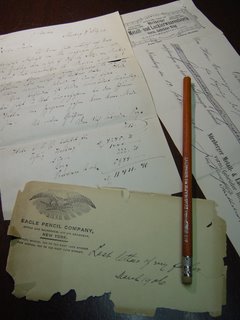My last post addressed recent news regarding allegations of illegally
imported Chinese pencils. In order to
avoid anti-dumping duties these pencils were apparently transshipped via third party countries such as Taiwan, Vietnam and
Indonesia and mislabeled as to country of origin. Today I am addressing the
overall U.S. market for pencils and future of U.S. production of pencils relative
to how I see this topic coupled with other developing industry trends.
legal case I believe this is a positive development for U.S. pencil
manufacturers and other established pencil industry participants who are
committed to making quality products and playing by the rules when it comes to
all manner of international trade, environmental, labor and product safety
regulations. For the past 20 years the
trends of globalization, retail channel consolidation and other competitive market
forces have contributed to a dramatic shift in our industry structure just as
in many other industries. As a free
market thinker I do not believe these are inherently bad trends and they have
led to a number of benefits for society as a whole though those benefits may
not always be evenly dispersed and has not always resulted in comparable
product quality.
When it comes to pencils, both here in the U.S. and worldwide,
we are seeing more pencils sold and consumed at lower average prices than 20
years ago. Despite the common misconception that pencils
are a dying business, pencil consumption generally grows globally at or around
the rate of population growth. Also per
capita pencil consumption tends to increase with income growth as well. Providing
we continue our positive immigration trends we should see stable and slowly
growing demand for wood-cased pencils over the long term. Obviously income growth and dispersion is a current
concern in light of recent economic developments, but ultimately I still remain
optimistic about U.S. potential from the macroeconomic stand point.
The rise of computers, tablets, or smart phones over this
period have yet to prove to me that these technologies are going to displace
writing instruments and pencils as a whole.
Technology certainly can impact how and where we use pencils at the
margins. However, there is a strong emotional and tactile connection people have with
their preferred writing tools and the physical act of depositing graphite, ink, paint or
color pigments onto paper. What could
impact per capita pencil consumption even more than technology is allowing
another generation of kids to be raised without access to and experiencing the
use of good quality pencils. This could drive consumption patterns to alternate
writing instruments in the long term. Despite the benefit of ever cheaper wood-cased pencils on household budgets over the past 20 years , one negative byproduct has been exposing children, teachers
and other consumers to a general reduction in the quality of the average pencil sold here
in the U.S. At Pencils.com one of our
most common consumer questions is: “Where can I find a decent pencil at a
reasonable price in which the lead won’t break, the eraser works without
smearing and that actually writes well?”
Teachers often report that the simple act of more frequent breakage and sharpening has become a disruption in the classroom.
education in the U.S., especially when it comes to the provision of basic
school supplies. As a result the burden of supplying pencils and other suppliesis increasingly pushed onto teachers and families who have their own budgetconcerns. The drive for ever lower
prices has helped, but has also compromised quality and selection. As a result the assortment of pencils on retailers’
shelves has declined and the mix increased towards imported private label or
low price non-manufacturer brands. Lower
space allocation is offered to traditional quality manufacturer brands.
So what do a bunch of economic, social and demographic
trends have to do with an illegal transshipment case and whether this helps the
U.S. industry or not. The question lies
in part whether the retailers as a group, begin to see that price of pencils
cannot be their sole determining factor in the product mix as there are other
costs such as the associated anti-dumping duties and penalties. Also will consumers take a greater interest in the quality and origins of their
pencil purchases?
Sure they are still going to want the best price possible. However, I tend to think that a supplier who
is willing to illegally transship pencils is also a supplier who is more likely
to cut corners in product safety and quality.. These are all problems the retailers and
consumers don’t want to deal with over the long term. If retailers increasingly find they will be
held responsible for penalties, fines and consumer dissatisfaction as a result
of the potential negative aspects of their product supply chain then they are
going to increase their diligence in vetting and selecting their
suppliers. Certainly they cannot be
expert in every product range they sell and as they are importing many products
globally, the headache of assuring compliance on products with anti-dumping
duties and other safety or regulatory concerns may result in some level of
return for advice and supply to known domestic vendors for improved
reliability. This does not necessarily
mean an imported pencil will be replaced by a domestically produced one, but
the opportunity for engagement on that supply decision will certainly improve
for the U.S. producers.
towards some return to U.S. manufacturing in general. My belief is this ultimately will have some positive
benefits for the U.S. pencil industry also.
Labor costs in China are now increasing dramatically and though still quite
low relative to the U.S. are making it difficult for many general
manufacturing companies to find and retain qualified employees. Chinese labor regulations as well as other
environmental and bureaucratic regulations are beginning to impact the general
cost of doing business in China. This
first impacts those producers in China who play by the rules, but in time the effects should
spread further throughout the Chinese economy. Meanwhile, U.S. domestic energy costs
are declining with the increase in domestic gas exploration and development. Long lead times on overseas supply chains
complicate planning and inventory investment while domestic producers can often
be more flexible with quicker response times.
Another important concern within the pencil industry is that
Chinese basswood and other Chinese woods have come under pressure for use in
other domestic purposes. More wood is
coming from Russia which has less stringent regulatory oversight causing more
concern with legal wood supply issues. A
resurgence in total Chinese GDP growth from their current slowdown will have
further inflationary impact on global wood supply and thus eventually pencil
prices as well. In my personal
assessment we’ve seen a low point reached in global wholesale pencil prices
that was reached about two or three years ago.
There will always be some other part of the world, the next low cost
country, to move on to, but adequate quality wood supply and transportation
costs also have an important impact on pencil economics beyond labor costs and
regulatory environments. Overtime, the
developing world catches up in relative costs so the U.S. should be able to
adapt and innovate to remain competitive.
That is as long as we do not let our current political stagnation and
increasingly burdensome regulatory environment overwhelm us over the long term. As the U.S.
remains one of the most important global growers of trees this ultimately will
have some positive impact on a host of products manufactured from solid wood. As a result I do predict that we will
eventually see at least some small improvement in U.S. production of pencils and other wooden products over
time.
are certainly not prepared to return our slat manufacturing operations to the
U.S. However, we are increasing our
commitment to U.S. based wood supply with the recent introduction of our
Pacific Albus product range. Eventually
we expect this will be an increasingly relevant component of our business displacing Chinese and Russian Basswood and supplementing
our premium California Incense-cedar product range.
Additionally, we have recently made several small movements towards
U.S. production regarding our Palomino Brands pencil ranges. Recently we relocated the final eraser
tipping process for our Palomino Blackwing and Blackwing 602 pencils from Japan
to our Stockton, CA using a newly developed tipping process. This should improve tipping quality and responsiveness as demand for Blackwing pencils grows. Thought the pencils themselves will continue to be produced in Japan. Also, we are transitioning our Prospector and
Golden Bear products from Thailand production to the U.S. where we are working
with one of our slat customers Musgrave Pencil Company to produce these items.
The new “made in the USA” versions of both pencils will phase out our prior California Republic
versions and be available exclusively on Pencils.com in the coming weeks. These pencil items represent only a very minute segment of the U.S. pencil market, but do expand our commitment to
offering a “Made in the U.S.A.” product selection in our Pencils.com store.














 This post continues a series of Timberlines articles discussing the impact various world trade issues and practices have upon the Pencil Industry. In my previous
This post continues a series of Timberlines articles discussing the impact various world trade issues and practices have upon the Pencil Industry. In my previous 



 Other programs like the
Other programs like the